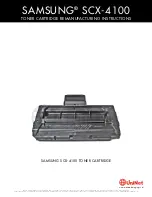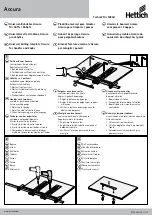
Switchpack:
Designed to be mounted externally to any junction box. When mounted, line connections are
inside the box and the Class 2 wiring exits through the rear of the switchpack housing. In areas
where Class 2 wiring is not permitted, the switchpack can be mounted internally to any
standard electrical box.
Limited Warranty
Wiring
LED will not turn ON:
• Verify 10-30 VDC across the red and black wires of the sensor.
• If there is no power at the sensor, check for 12-18 VDC at the switchpack output and
correct voltage at the switchpack input. Verify correct primary connections.
• If the voltage is OK at the switchpack, recheck all wiring and connections.
• If the LED still does not operate, please contact Cooper Controls’ technical service.
Lights will not turn ON:
• Confirm that no other switches or equipment are interrupting or bypassing power to the
switchpack or load.
• Short the blue and red switchpack control leads together to energize the relay.
• If the lights turn on, contact Cooper Controls’ technical service.
• If the lights do not turn on, check wiring on the switchpack load side and check the
switchpack contacts for continuity. Replace the switchpack if necessary.
Lights will not turn OFF:
In smaller rooms, the sensor may be activated by people moving in the hallway outside the room. Adjust the
Range control 1/8 of a turn decrements in the counter-clockwise direction or relocate the sensor. If the lights
will not turn OFF after the time period set on the sensor, and the LED has not lit during the time period:
• Confirm that no other switches or equipment are interrupting or bypassing power to the switchpack or load.
• Verify that the override switch on all sensor circuit boards is in the “auto” position.
• Check all connections to the switchpack.
• Temporarily unplug the sensor circuit board(s).
• If the lights turn off, the sensor is defective, and the circuit board should be replaced.
• If the lights do not turn off, replace the switchpack.
NOTE:
If multiple sensors/switchpacks are installed, check one at a time.
Manual-On Override Switch:
The OEC-U-XXXX-AF has a built-in override switch on the printed circuit board designed to turn the load
on in the event of sensor failure when the sensor can not be replaced immediately. The switchpack must
be operative for this switch to work. If the switchpack is defective, it must be replaced or bypassed to
activate the load.
To operate this switch, remove the cover of the sensor and move the override switch from the “auto” posi-
tion to the “on” position. All switchpacks connected to the sensor will now be energized. If multiple sensors
control the same switchpack(s), activating the override
switch on any one sensor will activate all switchpacks.
Sensor Cover Removal:
1. To remove the cover from the sensor unit, grasp
the end of the cover opposite the adjustment controls
and pull down gently. Unit will snap open.
2. Locate override switch.
3. To replace the cover, position controls to line
up with the holes in the center of the cover.
Unit will snap closed.
Wiring Diagrams
Checkout and Adjustment
Troubleshooting
Installation
Sensor:
Step 1:
Pass wires through the
threaded mounting post and
interlock to the backplate.
Step 2:
The sensor mounts to
normal ceiling tile through a
single 3/4” hole.
Step 3:
When mounted, the
sensor’s slotted grills must point
along the path where motion is to
be detected.
Step 4:
An adapter plate (ACMP)
is available to allow mounting to a standard fixture ring and junction box.
Step 5:
The threaded mounting post may be cut down if it is too long to fit into the junction
box. When a flat ceiling is not available or mounting to an angled surface is necessary, please
use the mounting adapter (ACMA-03).
CAUTION: Finger-tighten the nut to avoid stripping the mounting post.
All products manufactured by Cooper Controls and identified with the Greengate brand are warranted to be free from
defects in material and workmanship and shall conform to and perform in accordance with Seller’s written specifica-
tions for a period of :
Five (5) years from date of shipment for all occupancy sensors and Three (3) years from date of factory invoice for our
hardware and software on Lighting Control Panels.
We warranty all our standard relays for a period of 10 years from date of factory invoice. We guarantee the perfor-
mance of our system to specifications or your money back.
This warranty will be limited to the repair or replacement, at Seller’s discretion, of any such goods found to be defec-
tive, upon their authorized return to Seller. This limited warranty does not apply if the goods have been damaged by
accident, abuse, misuse, modification or misapplication, by damage during shipment or by improper service. There are
no warranties, which extend beyond the hereinabove-limited warranty, INCLUDING, BUT NOT LIMITED TO, THE
IMPLIED WARRANTY OF MERCHANTABILITY AND THE IMPLIED WARRANTY OF FITNESS. No employee, agent,
dealer, or other person is authorized to give any warranties on behalf of the Seller or to assume for the Seller any other
liability in connection with any of its goods except in writing and signed by the Seller. The Seller makes no representa-
tion that the goods comply with any present or future federal, state or local regulation or ordinance. Compliance is the
Buyer’s responsibility. The use of the Seller’s goods should be in accordance with the provision of the National
Electrical Code, UL and/or other industry or military standards that are pertinent to the particular end use. Installation
or use not in accordance with these codes and standards could be hazardous
.
Sensor Adjustments:
Once installed, the sensors must be adjusted for suitable sensi-
tivity and time delay. These adjustments can be made only after
the entire system is installed and power is applied to the switch-
pack and to the lighting circuit. Adjustments should be made with
the HVAC system on.
1. Using a small screwdriver, set the “Minutes” control to minimum by turning the adjustment
completely counter-clockwise. Set the “Range” control to the midpoint.
2. If override switches were installed, check their operation. Leave in the automatic position.
3. Stand completely still or leave the room. In approximately 15 seconds, the lights will go out.
4. Test the area of coverage by watching the red LED on the sensor. The LED lights only when
the sensor is detecting motion. Adjust the Range control to the lowest position that provides
adequate motion detection. Do not set higher than necessary. Test and set Range control for
each sensor if more than one was installed.
5. If the red LED blinks when no motion is being made or does not go off at all, air motion from
the HVAC system may be activating the sensor. Reduce the Range control until the LED goes
out and stays out when no one is moving. If this setting is too low to respond to normal
motion, the sensor may need to be relocated away from the air turbulence.
6. In smaller rooms, the sensor may be activated by people moving by the doorway outside the
room. Adjust the Range control toward minimum to prevent this.
7. Set the time delay Minutes control to the desired time for the lights to remain on after leaving
the area. Minimum time is approximately 15 seconds (for installer testing) - maximum is
about 30 minutes. The recommended time delay is usually 6-8 minutes. An eight-minute
time delay is approximately 11 o’clock on the Minutes control. People who remain very still
for long periods may need a longer time delay. If the lights go out while the room is occupied,
increase the time slightly until optimum time delay is reached.
Cooper Controls
203 Cooper Circle, Peachtree, GA 30269
800-553-3879
www.coopercontrol.com
P/N 910-0433
REV C
MOUNTING
POST
SENSOR UNIT
NUT
WASHER
ADAPTER
PLATE
NO. ACMP
SCREW
CAUTION: OEC-U-XXXX-AF is for use with 10-30 VDC only. For other voltages, refer to Greengate Tech
Sheets. Do not wire to control receptacle circuits. Confirm supply voltage before wiring the switchpack.
Make sure the switchpack is the correct model for the voltage being used. VERIFY that the connected
load does not exceed the switchpack ratings. Use twist-on wire connectors for all connections. All
installations should be in compliance with the National Electric Code and all state and local codes.
DO NOT control more than ten switchpacks with a single sensor.
Greengate sensors are provided with Teflon-insulated pigtails. The components are interconnected
using 18 AWG Class 2 wiring per NEC 725. Use UL-recognized Teflon insulated wire approved for
plenum areas per NEC 725-2(b) where required.
Wire the sensor(s), switchpack(s) and load as shown in the Wiring Diagram.
Controlling Multiple Circuits: CAUTION: In situations where an office is wired for multiple circuits
using separate hot leads, it is very important to connect only one circuit to each switchpack. You
may combine the low voltage wiring from switchpacks connected to different circuits. Consult with
the building manager and occupant to determine which lights should be off when the toggle switch
is open.
Multiple Switchpacks One Sensor
One Switchpack
Multiple Sensors
MANUAL-ON
OVERRIDE SWITCH
LED




















